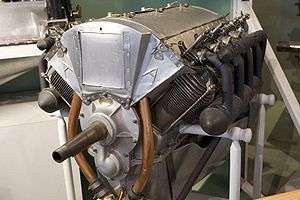Renault 80 hp
The Renault 80 hp, or Type WS in British service, was a V-8 aero engine that first ran in 1914. The engine was manufactured in Britain by Renault Limited of West Brompton, London between August 1914 and December 1918, seven other companies, including Rolls-Royce and Brazil Straker,[2] also produced the engine.[3] The Renault V-8 engines were noted as inefficient but reliable, the inefficiency being mainly due to the excessively rich fuel/air mixture used to assist cooling.[4]
| 80 hp/Type WS | |
|---|---|
 | |
| Renault 80 hp at the Canada Aviation Museum | |
| Type | Air-cooled V-8 piston engine |
| National origin | France |
| Manufacturer | Renault |
| First run | 1914 |
| Major applications | Airco DH.6 |
| Number built | 2,216[1] |
| Developed from | Renault 70 hp |
Applications
- Airco DH.6
- Alliance P.1
- Avro 548
- Farman MF.11 Shorthorn
- Farman F.41 and F.1,41
- Vickers F.B.7A
Engines on display
- A preserved Renault 80 hp is on display at the Canada Aviation Museum.
- A partially cut open Renault 80 hp engine is on display at the Science Museum in London (photo 1, photo 2)
- Another one on display at the Museo Nacional de Aeronautica in Morón -Buenos Aires-Argentina
Specifications (80 hp)
Data from Lumsden [3]
General characteristics
- Type: Inline air-cooled, upright, 90-degree, V-8 piston engine
- Bore: 4.13 in (105 mm)
- Stroke: 5.12 in (130 mm)
- Displacement: 548.9 cu in (9 L)
- Length: 50.6 in (1,285 mm)
- Width: 35.5 in (902 mm)
- Height: 35.3 in (897 mm)
- Dry weight: 463 lb (210 kg)
Components
- Valvetrain: Single overhead exhaust valve, single side inlet valve per cylinder.Although this valve arrangement is cited as "one side and one overhead valve," both valves are situated in a lateral pocket from/to which gases flow. Therefore both valves are "side valves" one on top of this lateral pocket and one on its bottom. There are no valves on the combustion chamber or on the overhead position.
- Fuel system: Single 32 mm Claudel-Hobson carburettor
- Fuel type: 40–50 octane petrol
- Cooling system: Air-cooled
- Reduction gear: 0.5:1, left hand tractor.(There is no proper "reduction gear". The reduction in this case is achieved due to the fact that the Airscrew is mounted on the Cam Shaft, therefore the shaft rotation speed, and so the airscrew, is half of the crank speed)
Performance
- Power output: 80 hp (60 kW) at 1,800 rpm (takeoff power)
- Specific power: 0.15 hp/cu in (6.7 kW/L)
- Compression ratio: 4.16:1
- Power-to-weight ratio: 0.17 hp/lb (0.28 kW/kg)
gollark: Additionally, your longer message fix would run into some accursedness I encountered with encodings.
gollark: Well, I don't think you ever populated `replyee` with any data.
gollark: Your PR was unfortunately wrong and not usable.
gollark: Anyway, I implemented the things you wanted.
gollark: ↑
See also
Related development
Comparable engines
Related lists
References
| Wikimedia Commons has media related to Renault 80 hp. |
Notes
- British production
- Gunston, Bill (1998). Fedden. Rolls-Royce Heritage Trust. pp. 35–37. ISBN 1-872922-13-9. Historical Series No26.
- Lumsden 2003, p. 181
- Gunston 1989, p. 135.
Bibliography
- Gunston, Bill. World Encyclopaedia of Aero Engines. Cambridge, England. Patrick Stephens Limited, 1989. ISBN 1-85260-163-9
- Lumsden, Alec. British Piston Engines and their Aircraft. Marlborough, Wiltshire: Airlife Publishing, 2003. ISBN 1-85310-294-6.
External links
This article is issued from Wikipedia. The text is licensed under Creative Commons - Attribution - Sharealike. Additional terms may apply for the media files.